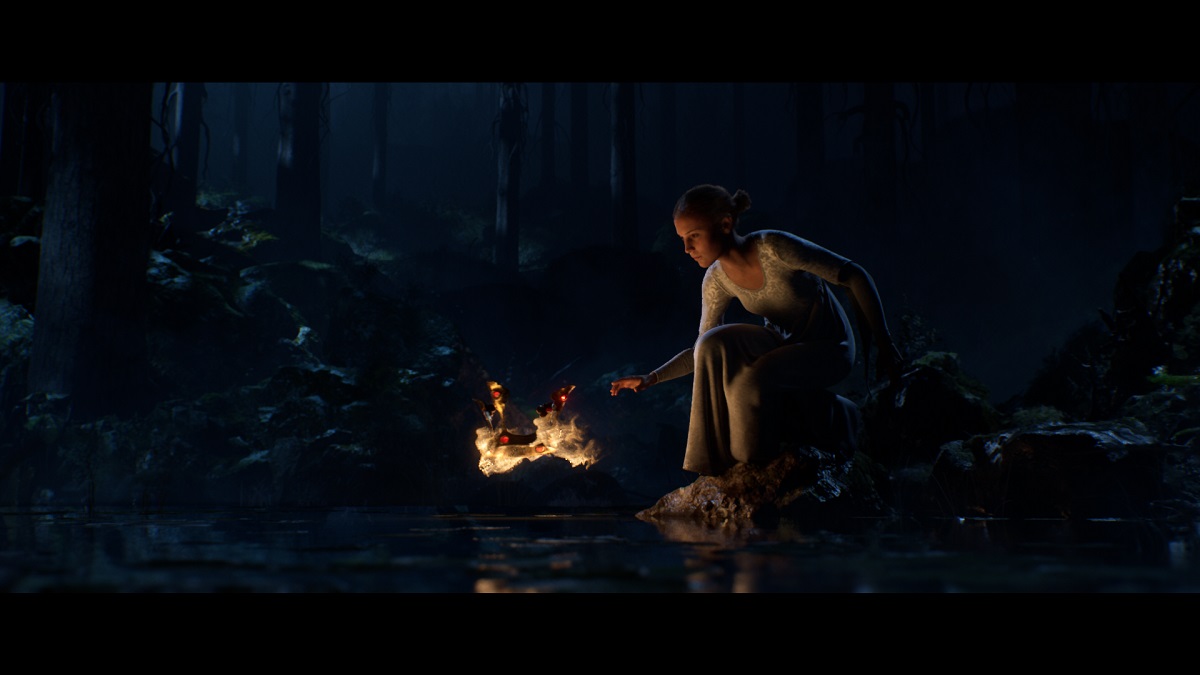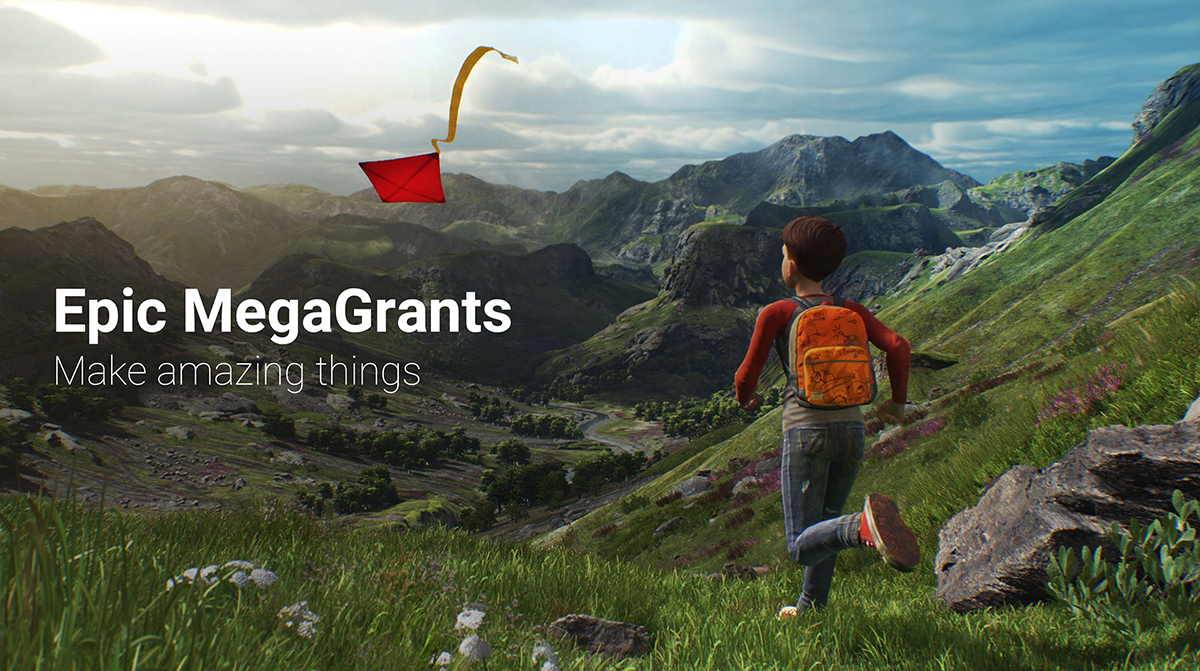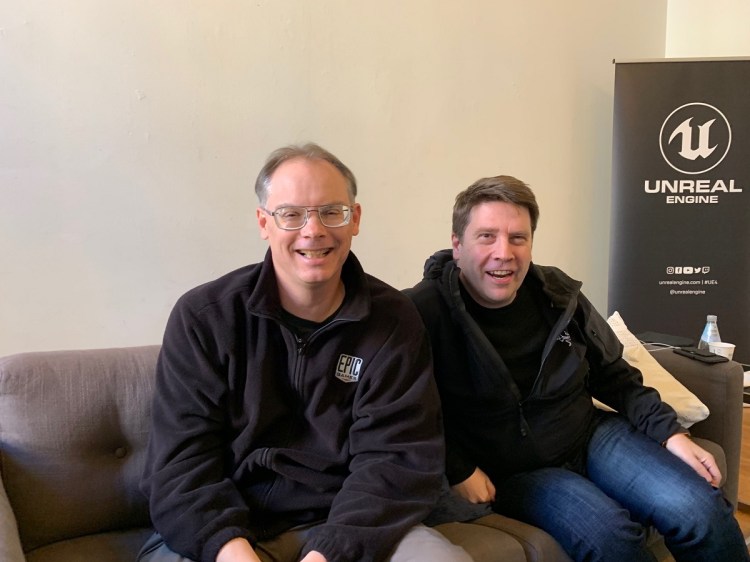Epic Games dumped a bunch of news about the state of the Unreal Engine at its keynote talk at the Game Developers Conference today. We got a preview of the news and were able to interview Tim Sweeney, CEO of Epic, and Kim Libreri, chief technology officer.
Sweeney said Fortnite has reached 250 million players, and that the popular battle royale game hasn’t seen a drop off because of rival EA’s popular Apex Legends. He said the largesse from Fortnite will enable Epic Games to set up a new $100 million fund for Unreal Mega Grants for game developers.
Sweeney also talked about his views on openness and open source technology. He praised Microsoft for its open approach on HoloLens 2 augmented reality technology, and he ultimately believes high-quality AR glasses will replace all of our screens, like smartphones, TVs, and movie screens.
Libreri and developers from Goodbye Kansas showed how much progress the company has made with digital humans, or making ultra-realistic human faces with real-time ray tracing. They created the believable human imagery of Trolls.
We discussed these topics and more ahead of the Epic talk at GDC 2019.
Here’s an edited transcript of our interview.

Above: Troll has some amazing digital human imagery.
GamesBeat: Can you talk about what’s going on in your keynote?
Tim Sweeney: We have some tech demos that Kim will deliver on physics and digital humans. We’ll be talking about Epic’s online services that we’re opening up to all developers on all platforms and all stores for free. And we’ll be talking about the state of the Epic Games Store. That’s the big news. We’re very close to hitting 250 million Fortnite players. Since Apex Legends came out, we’ve gained an Apex Legends worth of Fortnite players, which is amazing.
GamesBeat: Some people thought that Apex Legends might slow Fortnite down. I guess not.
Sweeney: We hit a Fortnite non-event peak twice after Apex was out. We haven’t seen any visible cut into Fortnite. It’s a funny thing. The only game you can see where its peaks cut into Fortnite playtime is FIFA. It’s another game for everybody, wildly popular around the world.
What Apex Legends has done is re-energized a lot of shooter players, people who come in and out of shooters depending on what’s popular. It’s awesome to see other games picking up on battle royale, adding their unique spin to it and advancing the state of the industry.
Kim Libreri: The first thing we’re demoing — do you know who Quixel is? They’re a photogrammetry company that makes a lot of assets, a big asset library of rocks and trees and plants and natural phenomena. If you’ve played any triple-A game over the last year or so and you’re going through a big open world environment, chances are that stuff came from Quixel. They contacted us before Christmas saying, “Hey, we have a movie we’re working on, and we’d love for you to open up with it at your GDC keynote.”
So we’re opening up with this movie that was made by three artists using their assets. It looks super photorealistic, and it was made in Unreal Engine 4.2.1, the current version, as opposed to the to-be-released version coming out next week, 4.2.2. It looks great. That represents the state of the art of rasterizing. This is the Unreal Engine before we did a large overhaul of the graphics systems in the engine.
We’ve now made the engine capable of raytracing out of the box. We’re no longer talking about prototype or demonstration stuff. We now have an engine that will raytrace. What we’re trying to explain to people is that raytracing is not just about shiny bottles or glass surfaces or doing a bit of refraction. It’s about subtlety. It brings a quality of lighting that you’ve really only seen in animated movies or live-action photography.

Above: Troll takes advantage of real-time ray tracing.
To show that off, instead of making a demo ourselves, we wanted to work with a customer that would get early access to 4.2.2 and make a short movie. It’s based on an old Swedish fairy tale by an author called Jon Bauer. It’s about a princess and fairies and a troll. They’ve made a little teaser, about one and a half minutes, a cinematic piece, all rendered in real time in front of the audience on an Nvidia 2080Ti. It’s a movie, so it’s 24 frames per second. It looks awesome.
The star of the short is a digital recreation of Alicia Vikander, the Tomb Raider actress. She was also in Ex Machina a few years ago, an amazing Swedish actress. She’s an amazing digital human. 3Lateral built the digital human. But the real story is a very gentle, beautiful fairy tale with amazing-looking lighting.
We’ll go over the features around raytracing, how adding raytracing forced us to do a rework of the engine. It has to still be backward compatible for existing customers. We can’t change everything to a point where they can’t load up their old scenes. But as a side effect the engine became faster, so rendering in Unreal Engine is now faster than it’s ever been. We’ll go through features we’ve added to deal with cross-platform performance, from Android all the way to high-end workstations, and then we have a gameplay demo that shows off something we felt was a long time coming to the games business.
We’re in the danger, as an industry, of entering into an uncanny valley not around digital humans, but around interactions. You can walk around an environment built in Unreal Engine that looks pretty photographic. With raytracing now it looks very photographic. But if you pick something up or try to fracture a wall or knock down a door, you get met with very simple rigid-body physics, relatively simple collisions — physics is still in a simple state in the game industry.
We wanted to have a go and see if we could learn some lessons from the movie industry over the last 10 years. Can we do large-scale simulation and collision and destruction and particles that bring to the world something like the spectacle of a Michael Bay movie, but in a video game? We made a gameplay demo that shows killer destruction and cool explosions and all the stuff that — what would it be like to really blow up an environment? That’s the physics demo.
We call it Chaos, the new physics system. It’s all running on an Intel Core i9. They were quite instrumental in helping us make sure things were running as fast as they possibly could. It’s mind-blowing. Shit blows up all over the place. You’ll be able to play that demo at our booth. We’ll have two setups that can people can go in on, massive screens where you can blow up this robot city.
Magic Leap will also be bringing their Mica demo to our booth, so you’ll be able to interact with a digital human. Vlad from 3Lateral is going to talk a bit about our plans going forward in terms of wanting to ubiquitize the creation of digital humans, so it’s not a super-hard, expensive endeavor. That’s what it is right now for most developers. It’s out of reach. Most small studios cannot put quality digital humans in their games. It’s just too difficult. We’re going to talk a bit about that.

Above: Troll’s shadows
GamesBeat: There was an investor, Cyan Banister, putting a lot of money into different digital human companies. They’re doing a conference on digital humans coming up.
Libreri: Yeah, there’s loads of companies. That space — most companies that make digital humans are pretty bespoke, and they’re heavily labor-oriented in terms of the amount of chiseling they have to do to create every expression. What Vlad has done over the last decade is build digitization processes, rigging processes, and tools that make it very easy for him to get a character from the scanning of the human into a movable character, but with a basis for animation that’s standard across all characters.
If you tell character A to smile, you can take the exact same animation data and apply it to character Z, and they’ll smile with the same feeling, even if they have a biomechanically different face. That gives us the benefit of being able to mix and match features to start making unique digital humans. We have some cool ideas of where we want to go with that. But it’s still one of the hardest things.
GamesBeat: Will you have an interactive demo related to that?
Libreri: There will be a little virtual camera that shows the lighting features in the raytracing. The digital human, mixing faces, that will be something that we do later down the line. We’re pretty packed at this point.
The other thing we’ll talk about a little bit is the multi-user system. We’ve made it so that if you have multiple people working in Unreal Engine and they’re working on the same scene together, they can share stuff. If I decide to move this water bottle here, you can connect to the central session and you’ll see that move in real time. When you’re trying to do a playtest or an art review with an art director — or in the case of making a movie with virtual production — people can all go into the VR editor and see what each other are doing.
If you’re trying to make a movie, to tell a story, you can have the actors see each other. You can have the director see it all. You can have a cameraman viewing the scene. We’ve made this multi-user sharing thing which — it would be very hard for our competitors to do this. It was pretty hard for us to get it to work, but it’s a pretty amazing feature. We’ll talk a bit about that, but we’ll probably leave the big discussions for SIGGRAPH.
GamesBeat: I wonder about some of these stumbling blocks people have identified. One of the things people have said about Frostbite is that it’s good for what it does, the destruction, but for something like what Visceral was trying to do, the Star Wars game that wound up getting cancelled — other things it’s not so good for. It seems like some engines out there are specific to a particular thing they’re trying to do. I wonder when we get to the point where we have engines that do everything.
Sweeney: Engines have to solve all problems. The cost of building an engine now is hundreds of millions of dollars, representing the work of hundreds of people for many years. You can’t build an engine that’s just good for one type of game anymore. The economics don’t work.
Libreri: And you can’t make an engine that’s really great unless you push it yourselves. Gears of War was awesome. Unreal Engine 3, in its early years, you could make an awesome game like that. This era, I think we’ve gone through a few different iterations of different types of games, beyond making a Gears of War storytelling action game. We’ve done Paragon. We’ve done Fortnite, which is a big multiplayer game with massive community. The engine has evolved because of that.
We try to make something that’s as general-purposes as possible, but you really need to — it’s where the rubber meets the road that makes an engine great. At this point, between what we do and what our customers do, there are enough varied applications that we scale pretty well. There are a few things that we can do better at. We could be better at open worlds. We have a lot of smart people on our engine team thinking about how we can build the super-scale ecosystems of the future. But a lot of it is down to how you push it. Every day we push it, across all the platforms.

Above: Epic Games is giving out $100 million in Epic MegaGrants, with no strings attached.
Sweeney: Unreal has to be an engine for everyone who wants to build a major game. Especially with the investment in tools — where a lot of the internal engines succeed is that they have a lot of amazing features, but they suffer in terms of ease of use for developers. Content teams will lose out if they’re using an inefficient tool set. We put huge effort at Epic into making the tools productive, whether you’re starting a project or finishing it up and optimizing. Everything in the engine that we use to maintain a live game like Fortnite, with weekly content releases at a huge scale, always working on every platform, that’s a huge investment.
Libreri: Think about the variety of games that are running on our engine now. There are open world games. There are massive multiplayer games. There are story-based action games. There are indie games like Astroneer. Lots and lots of stuff. We’re in a good place.
One of the challenges for Amy Hennig’s game was cinematic production. She makes very cinematic games that need to cut in and out of cinematics seamlessly. That might have been a challenge. Not to knock Frostbite, because they’re a very good team with very good people. They would have hacked it. But you can’t build, in one go, something for everyone. You have to evolve something over time.
Sweeney: The cinematic tools, the sequencer, we have some of the best in the industry. They’re getting better and better for even larger-scale games.
GamesBeat: Are you going to hit the open-source stuff, the issue of openness in the industry at all?
Sweeney: Oh, yeah. Unreal Engine remains open source. You know that we created a $5 million fund for grants disbursed over the last three years. The last funds have gone out this past week. What we’re doing now is we’re creating a new fund called Epic Megagrants. [laughs] These are also no-strings-attached grants. They’re not contracts to do anything for Epic. You just apply, and if we judge your project is worthy and reasonably planned-out, we’ll give you funds. They range from supporting game developers to supporting enterprise and educational, academic projects. Open source projects that have any impact on the digital ecosystem at all, even if it doesn’t have any bearing on Unreal. We’ll be disbursing $100 million of Fortnite V-bucks.
GamesBeat: Did you want to change the nature of that in some way as you go to this new set of funds?
Sweeney: We’re enlarging it, obviously, and we’re specifically creating a category for funding open source projects of all sorts. For client side tools, for pipelines. We have partners who are interested in open file formats, open source pipeline tools. In the operation of our own games, we use a lot of open source components, and we’ll be directing some funding to those. We’ll just have an open process for funding things that we don’t even know about ourselves now.
Libreri: We’ll have academic projects, maybe museums applying for grants, researchers, different curricula. By funding open source tools, we’ll be helping developers build more cool things for other developers. We want to encourage that.
Sweeney: Another outreach effort where we’re working with industry partners to connect all our social systems — Epic has an account system. Uplay has an account system. Xbox and Sony and Nintendo and Steam have account systems. Everyone has friends that are limited to one platform and ecosystem. Whereas what we’ve built with Fortnite is a friends system that works across seven platforms. You can have friends across Xbox and PlayStation and PC.
We’ve already announced a partnership with Ubisoft, and we’re working on more. We’re going to enable customers with Epic and Uplay accounts to link them together and have access to all their friends across all the platforms. We’d love to work with more. We’re trying to create one ecosystem, an effort to link up all the networks so that everybody’s systems can participate as peers, and not with Epic as the central focus of this. We’re going to be a player alongside everyone else.

Above: Chaos shows physics and destruction.
GamesBeat: Does everyone want to go along?
Sweeney: Some do. [laughs]
GamesBeat: You found a reason to praise Microsoft in a recent talk.
Sweeney: They made a very sweeping statement there. HoloLens and all Microsoft augmented reality efforts will be set up as open platforms, where any developer can create software that any user can install. Anybody can create a store that’s a peer to Microsoft’s own store. That’s a huge thing.
I believe that over the next 10 or 15 years, smartphones and monitors and televisions will be replaced with AR. This will be the platform of the future. It’ll have IMAX-quality 3D graphics supported everywhere we go in the glasses on your head. It defines a completely new set of opportunities for games and game developers.
Microsoft has a stellar piece of technology in HoloLens and an amazing road map of future plans to extend it. They also have a very practical strategy where now — before this technology has been consumerized, the rubber is hitting the road. We’ve seen the adoption of HoloLens in enterprise applications, where professionals are using it as part of their day to day jobs and getting huge benefits out of it. It’s still not a consumer format. But they’re building AR and working on it every day. They’re building toward a future where it’s ubiquitous.
Libreri: AR as a tool is incredibly important. It’s not a fad. It will absolutely get massively accepted and used in the enterprise space.
Sweeney: Microsoft will be a major platform in AR. HoloLens is an enterprise-focused product, but in the coming years there will be a billion-user version of AR. To know now that one of the major platforms will be an open platform for all to participate in, that’s going to make it very hard to launch a closed platform and get publishers and developers to buy into it. They don’t want another walled garden between them and gamers.

Above: The Epic Games Store is focusing on developers in competing with Steam. Is it enough?
GamesBeat: With the store, Valve started out Steam as an alternative of a kind as well. Somehow they came out to be the bad guy. I saw the GDC survey this year where most people think Steam doesn’t earn its 30 percent. How do you proceed with your store, but still remain on the side of openness?
Sweeney: It’s a long arc for the industry. When Valve launched Steam it was really revolutionary. Most publishers took 70 percent and gave developers 30. Valve launched Steam giving developers 70 and taking 30. It was an amazing deal at the small scale at which it launched.
Despite that, remember the first years of Steam? Everyone hated it. They thought it was a virus, Valve forcing this malware onto their PC that made them go through this weird launcher to get to their games. But what Valve did was right. They transformed the PC ecosystem and inspired all the other digital storefronts. As a result, the digital storefront industry is a $100 billion per year market across all platforms worldwide. $100 billion a year selling software online.
The difference between that and Steam in 2004 — operating Fortnite ourselves as a major PC e-commerce platform has shown us that there are now massive economies of scale. Mastercard and Visa and Paypal processing cost maybe 3.5 percent in the western world. CDN bandwidth costs maybe 1 or 1.5 percent. Customer service costs 1 or 1.5 percent. But we see all these 30 percent storefronts, at least in the west. Companies in major developed economies are marking up their costs by a factor of five or six.
Libreri: You don’t even need software developers to build out the infrastructures. In those days the amount of developers that Valve would have needed to work on the infrastructure was high compared to the number of consumers. The scale is totally different these days.
Sweeney: The marginal costs are negligible. That’s why we launched at 12. Epic’s 12 percent is a permanent rake. That’s not going to go up. It’s going to be a profitable business for Epic at those margins. It’s a real business, not just some weird introductory rate or a loss leader. There’s nothing we hate more than companies that charge us for our products in forms that are worse than money. [laughs]

Above: Dauntless is a new title in the Epic Games Store.
GamesBeat: Are there any things besides the percentage that you need to be aware of to keep the store popular?
Sweeney: For users, there’s a free game we’re releasing every two weeks. Most companies bring users to their product by paying Facebook and Google tons of money to send them their way. We’ve found we can get more customers into the Epic Games Store by taking that money and paying it to developers for permission to release their game for free for two weeks. The developers benefit by getting that money and by building awareness of their games, especially when they’re building a sequel or a new product. It’s valuable to build an audience around your brand. We’re giving consumers a free game, meanwhile, and as a result we’re getting more users into the Epic Games Store more economically than by paying these megacorps, and that’s a good thing.
We have exclusive games in the Epic Store, of course, that are providing unique value and bringing users in. Between all that we’re seeing massive growth, well beyond our expectations. When we gave away Subnautica that brought in 4.5 million users to the Epic Games Store. We have another game that did close to that. Stay tuned on Wednesday for the numbers. We think we’ll be near that. We have a huge influx of users from new games, a huge influx from exclusives. The whole thing is gaining traction. It’s working.
We find that 99 percent of gamers are driven by games. They want great games, and they’ll go where they games go. We find that most Koreans install Steam just so they can play PUBG. Most users who have Origin installed have installed it to play Apex Legends now. Fortnite players install our store because of Fortnite. Metro Exodus players install the Epic Games Store for Metro Exodus.

Above: Mica is Magic Leap’s digital human.
First and foremost, our industry is about games. There are different specialized desires among people who, say, want everything on Steam. A lot of folks don’t like exclusives. But exclusives are the key to building any new content ecosystem. You see that on console with games like Halo and Gears of War driving Xbox adoption, or PlayStation with God of War. Steam has Counter-Strike. Origin has Apex and FIFA. This is the way content ecosystems are built. We feel it’s a necessary change for the industry, to evolve into better revenue sharing. We have to have new stores come along. We have to have stores improve the economics for everyone.
Giving developers more money right now — to gamers right now it’s a kind of invisible thing. They don’t really care about the deal terms between developers are store. But the secondary effects of that — first of all, many developers make less than 30 percent profit margins. Going from 70 percent to 88 percent is no small deal. In many cases it’s enough to go from a little bit unprofitable to reasonably profitable. The knock-on effects of that mean they’re building better games, and to some extent passing along the savings to customers, because they realize that by lowering their prices, they can sell more copies. At higher revenue shares for them they can make more money by giving consumers a better deal.
Economic competition goes through iteration. The knock-on effects of this are going to be pervasive across the whole digital ecosystem, on everything from prices to selection to quality of games.
GamesBeat: The one thing that surprised me was how Unity’s SpatialOS — it’s a problem I didn’t expect to see. I don’t know if that surprised you as well, or if this is one more area where you have to be vigilant about who’s allowing what in their content agreements.
Sweeney: That surprised us. It might have just been some clueless lawyer somewhere who updated Unity’s terms of service to say that you can only sell through stores Unity approves, and you can only use online services Unity approves. That would basically give Unity the ability, if they chose to use it, to knock out store competitors like Steam or the Epic Games Store. Unity very quickly responded to update their terms of service to remove all that. But it’s starting a useful conversation in the industry. I wouldn’t ascribe any malice to the situation. It was a problem that arose unexpectedly and was quickly corrected.
Developers rely on the ability to use a wide variety of tools and services. It’s renewed our focus on making sure that every component of Epic’s offering is open to everyone and can be interchanged freely. You can use the Unreal Engine for a project on any platform, in any store. It’s completely your choice. You can use our Epic Online Services on any platform across any store for free, including competing stores. You have no obligation to ship on our store. Everything works. You can put games from any engine on our store and use any services you like. Developers are free to mix and match and choose.
That’s the principle our developers rely on in order to make sense of their world. Can you imagine how dysfunctional it would be if you were only allowed to use one physics system on one console and another one on another console? Now you have to build physics twice? That doesn’t work. But that was the situation that was slowly arising with friends and matchmaking and stuff. It’s great that it’s all being sorted out.
These are all valuable conversations. When people dig into the details of contracts and programs, it forces companies to be honest and to stick with practices that are good for everyone.

